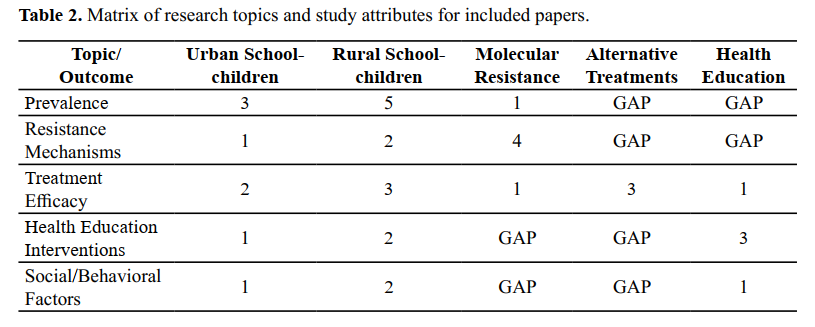A COMPREHENSIVE REVIEW OF EPIDEMIOLOGY, RESISTANCE AND TREATMENT OF PEDICULUS CAPITIS IN THAILAND
DOI:
https://doi.org/10.55374/jseamed.v9.248Keywords:
Pediculosis capitis, Thailand, Drug resistance, Alternative treatment, Health educationAbstract
Background: Pediculosis capitis, or head lice infestation, is a significant public health issue in Thailand, particularly among school-aged children. Prevalences are high, ranging from 23% to over 80% in various communities. A significant challenge to control efforts is the widespread resistance to common chemical treatments, such as permethrin, caused by knockdown resistance (kdr) mutations. This situation calls for a review to address these challenges to guide public health policies.
Objective: This review aims to consolidate the current literature on the epidemiology, resistance, and treatment strategies for pediculosis capitis in Thailand, highlighting key findings and ongoing challenges.
Methods: A comprehensive search was conducted across five bibliographic databases: PubMed, Scopus, Web of Science, Thai Journals Online (ThaiJO), and Google Scholar, from which 15 relevant articles were selected for this review.
Results: Epidemiological studies confirm a high prevalence of head lice among Thai schoolchildren, reaching up to 83.9% in some areas, with girls being more frequently affected. Molecular studies detected a high frequency of kdr mutations (97.4%) in lice populations across Thailand, which are strongly linked to treatment failure for 1% permethrin lotion (failure rate of 47.5%). Alternative treatments have shown high effectiveness; oral ivermectin achieved a 94.8% cure rate, and 4% dimeticone demonstrated 100% mortality in ex vivo tests. A herbal shampoo demonstrated a 100% cure rate (compared to 3.3% for the placebo), and health education programs reduced the prevalence from 59.2% to 44.1%, while also improving knowledge and practices.
Conclusion: Pediculosis capitis remains a persistent challenge in Thailand, characterized by a high prevalence and significant resistance to permethrin. Alternative treatments, such as ivermectin and dimeticone, combined with health education, are effective ways to control the condition. Future efforts should focus on integrated strategies that combine molecular surveillance and community-based education to tackle drug resistance and the social factors that sustain infestations.
Downloads
References
Singhasivanon O, Lawpoolsri S, Mungthin M, Yimsamran S, Soonthornworasiri N, Krudsood S. Prevalence and alternative treatment of head-lice infestation in rural Thailand: a community-based study. Korean J Parasitol 2019; 57: 499-504. DOI: https://doi.org/10.3347/kjp.2019.57.5.499
Rassami W, Soonwera M. Epidemiology of pediculosis capitis among schoolchildren in the eastern area of Bangkok, Thailand. Asian Pac J Trop Biomed 2012; 2: 911-4. DOI: https://doi.org/10.1016/S2221-1691(12)60250-0
Kitvatanachai S, Kritsiriwutthinan K, Taylor A, Rhongbutsri P. Head lice infestation in pre-high school girls, Lak Hok suburban area, Pathum Thani Province, in Central Thailand. J Parasitol Res 2023; 2023: 8420859. DOI: https://doi.org/10.1155/2023/8420859
Thanyavanich N, Maneekan P, Yimsamram S, Maneeboonyang W, Puangsa-Art S, Wuthisen P, et al. Epidemiology and risk factors of Pediculosis capitis in 5 primary schools near the Thai-Myanmar border in Ratchaburi Province, Thailand. J Med Assoc Thai 2009; 92(Suppl 6): S70-4.
Fan C, Liao C, Wu M, Hu N, Su K. Prevalence of Pediculus capitis infestation among school children of Chinese refugees residing in mountainous areas of Northern Thailand. Kaohsiung J Med Sci 2004; 20: 175-9. DOI: https://doi.org/10.1016/S1607-551X(09)70104-4
Brownell N, Sunantaraporn S, Phadungsaksawasdi K, Seatamanoch N, Kongdachalert S, Phumee A, et al. Presence of the knockdown resistance (kdr) mutations in the head lice (Pediculus humanus capitis) collected from primary school children of Thailand. PLoS Negl Trop Dis 2020; 14: e0008955 DOI: https://doi.org/10.1371/journal.pntd.0008955
Brownell N, Sunantaraporn S, Seatamanoch N, Kumtornrut C, Siriyasatien P. The association between knockdown resistance and treatment outcome of 1% permethrin lotion in head lice infestations in Nonthaburi Province, Thailand. Arch Dermatol Res 2024; 316: 410. DOI: https://doi.org/10.1007/s00403-024-03428-9
Yingklang M, Gordon C, Jaidee P, Thongpon P, Pinlaor S. Comparative efficacy of chemical and botanical pediculicides in Thailand and 4% dimeticone against head louse, Pediculus humanus capitis. PLoS One 2023; 18: e0287616. DOI: https://doi.org/10.1371/journal.pone.0287616
Soonwera M. Efficacy of herbal shampoo base on native plant against head lice (Pediculus humanus capitis De Geer, Pediculidae: Phthiraptera) in vitro and in vivo in Thailand. Parasitol Res 2014; 113: 2945-52. DOI: https://doi.org/10.1007/s00436-014-3986-6
Yingklang M, Sengthong C, Haonon O, Dangtakot R, Pinlaor P, Sota C, et al. Effect of a health education program on reduction of pediculosis in school girls at Amphoe Muang, Khon Kaen Province, Thailand. PLoS One 2018; 13: e0198599. DOI: https://doi.org/10.1371/journal.pone.0198599
Faiza M, Rampal L, Laily D, Salmiah MS. Development of a health education module for the school-based health education intervention to improve the knowledge, attitude and practices on pediculosis capitis. Int J Public Health Clin Sci 2018; 5: 273-82. DOI: https://doi.org/10.32827/ijphcs.5.5.273
Eremeeva M, Durden L, Eisenstat J, Hargrove B, Mondor E. A severe head louse (Pediculus humanus capitis) infestation: timeline, pathogen detection, kdr-gene screening and morphological anomalies of lice. Med Vet Entomol 2024; 38: 247-59.
Subahar R, Hadyansyah R, Aldilla R, Yulhasri Y, Winita R, Dwira S, et al. Toxicity of 6-gingerol and Cymbopogon citratus against Pediculus humanus capitis De Geer (Phthiraptera: Pediculidae): mortality, detoxifying enzymes, and morphological ultrastructure alterations in lice. Res Vet Sci 2024; 177: 105364. DOI: https://doi.org/10.1016/j.rvsc.2024.105364
Utami A. The efficacy of herbal shampoo from Cymbopogon citratus and ultrasonic sound to control head lice (Pediculus humanus capitis). Int J Infect Dis 2020; 101: 321. DOI: https://doi.org/10.1016/j.ijid.2020.09.553
Sungkar S, Dwinastiti Y, Haswinzky R, Irmawati F, Wardhana A, Sudarmono P, et al. Effectiveness of wet combing compared with 1% permethrin lotion for the treatment of pediculosis capitis. Int J App Pharm 2019; 11(Special Issue 6): 1-3. DOI: https://doi.org/10.22159/ijap.2019.v11s6.33570

Downloads
Published
How to Cite
Issue
Section
License
Copyright (c) 2025 Journal of Southeast Asian Medical Research

This work is licensed under a Creative Commons Attribution-NonCommercial-NoDerivatives 4.0 International License.
The Journal of Southeast Asian Medical Research will hold the copyright to all published articles. The publisher's production department handles copyright forms once a manuscript is accepted and scheduled for publication.







